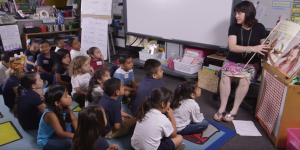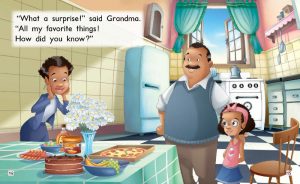
Shared Reading Books
Well-constructed big books for Shared Reading are a powerful and multilayered instructional tool. But choosing the right book for Shared Reading means more than just choosing a book that is “big.”
Often, the first thing we think about when it comes to choosing books is level. Level, however, only matters when choosing guided reading texts, not when selecting texts for Read Aloud, Shared Reading, or Independent Reading.
Here are four questions to ask yourself when selecting a text for Shared Reading, each having to do with intentional design elements and story-crafting that will create opportunities for learning.
How to Make Shared Reading Fun
Good Shared Reading books should be interesting to students. Relevant topics that engage children are important. Topics enjoyed by students include families, play, school, pets, and nature. Connections to topics such as these engage young readers and provide a context for discussion and language development.
Shared Reading Books for Kindergarten
For example, In the Fairy Tale Woods is a delightful book where well-known storybook characters hide in the forest. Each 2-page spread shows a forest where characters and items from the story are “hidden.” The text along the bottom of the page asks children “Can you find…?” and shows up-close illustrations of the characters or story items, such as Cinderella and her glass slipper. Children use language, such as position words, to describe where those items are located in the illustration: Cinderella is in the grass on top of the hill.
What Big Ideas Are Represented?
Along with interesting topics, good Shared Reading books should offer lots of big ideas for discussion. Those ideas are found in words and in illustrations or photographs. Even a book with simple and repetitive text will have multiple layers for thinking and discussing. For example, a book such as In the Tent—a story written with rhyme and rhythm about two children camping in the backyard—has multiple ideas presented: why someone would want to camp, equipment needed to camp, family members joining the experience one-by-one, and when one more camper proves to be just one too many. The multiple, interesting ideas mean children want to reread the book over and over to think more about the ideas.
What Variety of Support Is Provided in the Text?
There should be lots of supports designed for emergent and early readers, leading to multiple opportunities and support for rereading. Good Shared Reading books are designed to be used over and over throughout the school year. The illustrative and print supports offer students opportunities to learn to use all three cueing systems (semantic, syntactic, and graphophonic) in an integrated fashion. The rhyming, rhythmic, and repetitive language scaffold students to read the texts for themselves after the book is used several times in whole group lessons.
Another layer of support in a quality big book for Shared Reading is found in the print itself, which is controlled in several ways. The font used is large and uses thicker lines on each letter formation so the print can be read from a distance. For emergent and early readers, the placement of the print on the page supports students to develop several concepts of print: differentiating print and illustration, understanding where to start reading, and left to right, top to bottom across two-page spreads, to name a few. In quality big books, the fonts for emergent and early readers are sans serif. No squiggly a’s or g’s; books use a’s and g’s. In other words, the fonts are like what children will learn to form and write for themselves. Large spacing between words and between lines of text is another print element to support concepts of print development. The large spaces support children to develop a sense of word boundaries and line boundaries in print.
Another key factor in quality big books for emergent and early readers is with line breaks. Just as in emergent and early guided reading books, phrases are kept together on a line to encourage fluent, phrased re-readings and support meaning. For example, in the book A Pizza for Bear, one line reads “His mouth drools”; the following line reads “with great big drips”. While there was space to put the word “with” on the same line as “his mouth drools”, the word “with” is placed on the same line with “great big drips” because it is included in the phrase “with great big drips.” These phrases are kept together on a line to support students in accurate rereading of the print. This supports their ability to accurately track print for themselves as they reread the texts independently.
What Opportunities for Learning are Offered?
Texts for Shared Reading offer multiple opportunities for learning skills and strategies. Because good big books are written to be used multiple times throughout the school year, multiple possibilities for demonstrations are layered in.
For example, in Grandma’s Favorite Things—a story of a grandpa and granddaughter shopping for Grandma’s favorite things—the text uses detailed illustrations and words of varying complexity.
There are strong alliterative elements on each two-page spread: in each store, the items considered and ultimately purchased all begin with the same first letter, supporting phonological awareness and phonics understandings. There are some pages where the items use a blend, rather than a single consonant. On some pages, there are compound words and words with varied spelling patterns.
In addition, on each two-page spread, not all the items in the illustration that begin with that indicated consonant are named in the printed words. For example, on a page where the items all begin with letter p, there are pears and pineapples to discover in the illustration—things that weren’t identified in the printed words.
Though a book is intended for emergent and early readers, authors shouldn’t skimp on rich vocabulary. In A Pizza for Bear, author Nancy O’Connor uses rich vocabulary throughout the book. Words like slurp, sniffs, gleam, and drools. Don Holdaway said, “If children are reading favorite books they have enjoyed several times, they can cope with surprisingly rich vocabulary.”
Each of these word and illustration choices are deliberately layered into good big books to offer teachers and students multiple reasons to return to the book, depending on the needs of the learners in the classroom. These layers of meaning also allow for children to notice things for themselves on re-reads.
Finally, pre-K and K teachers often ask about why Shared Reading books have multiple lines of text rather than a single line. One-to-one match and return sweep are more easily developed because of factors like print placement and line breaks, not because there is only one line of text. And because the text has more print, the text has more learning opportunities than a text restricted to a single line per page might offer. Because Shared Reading is a heavily supported instructional approach, students are able to cope with more text on a page than they could otherwise.
Rather than thinking level when considering a big book, think about these four questions to help you select the best books for Shared Reading.
For more information about any of the titles mentioned in this article, please visit Myokapi's Lift Off to Literacy. Debra Crouch.

